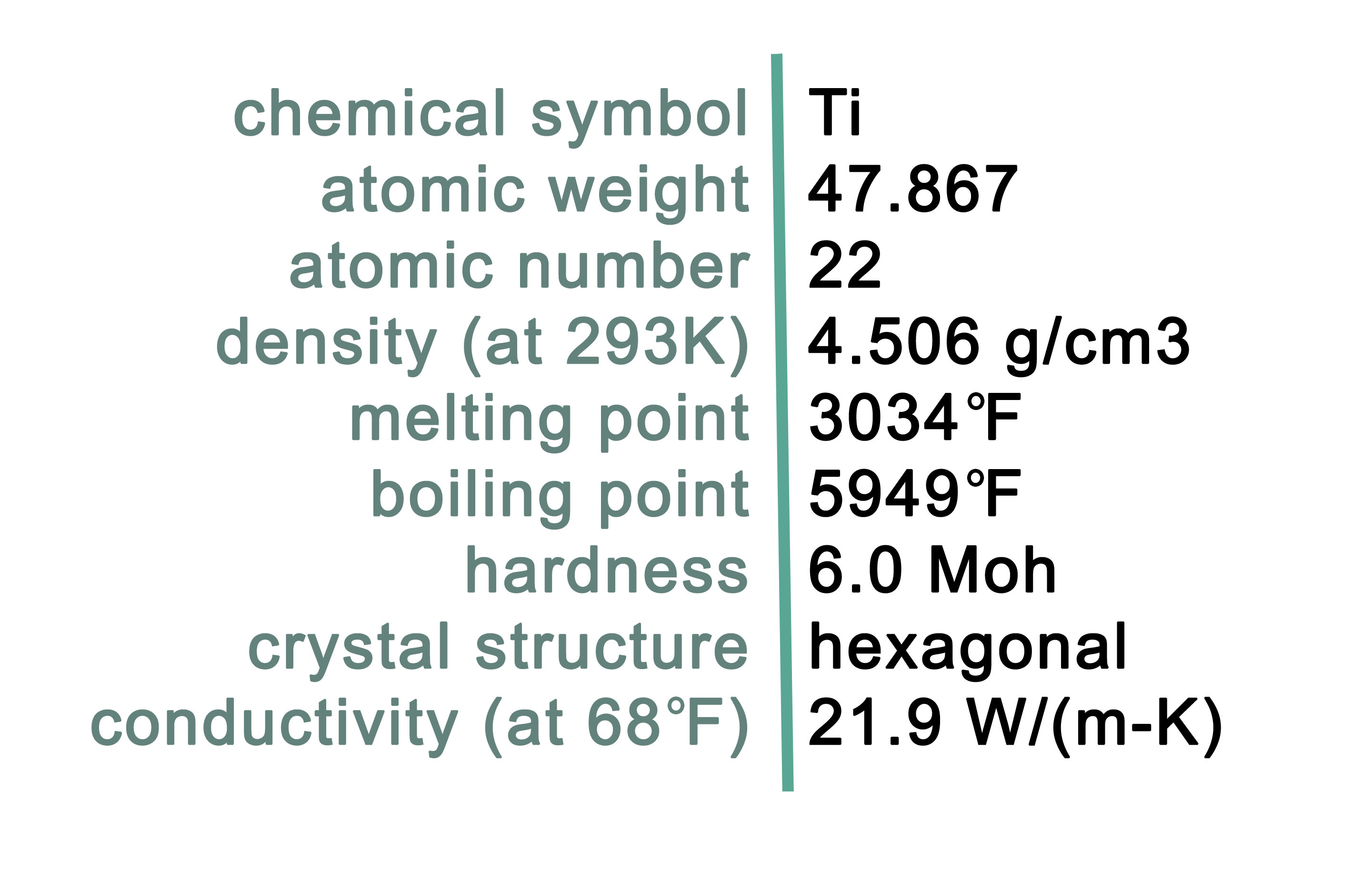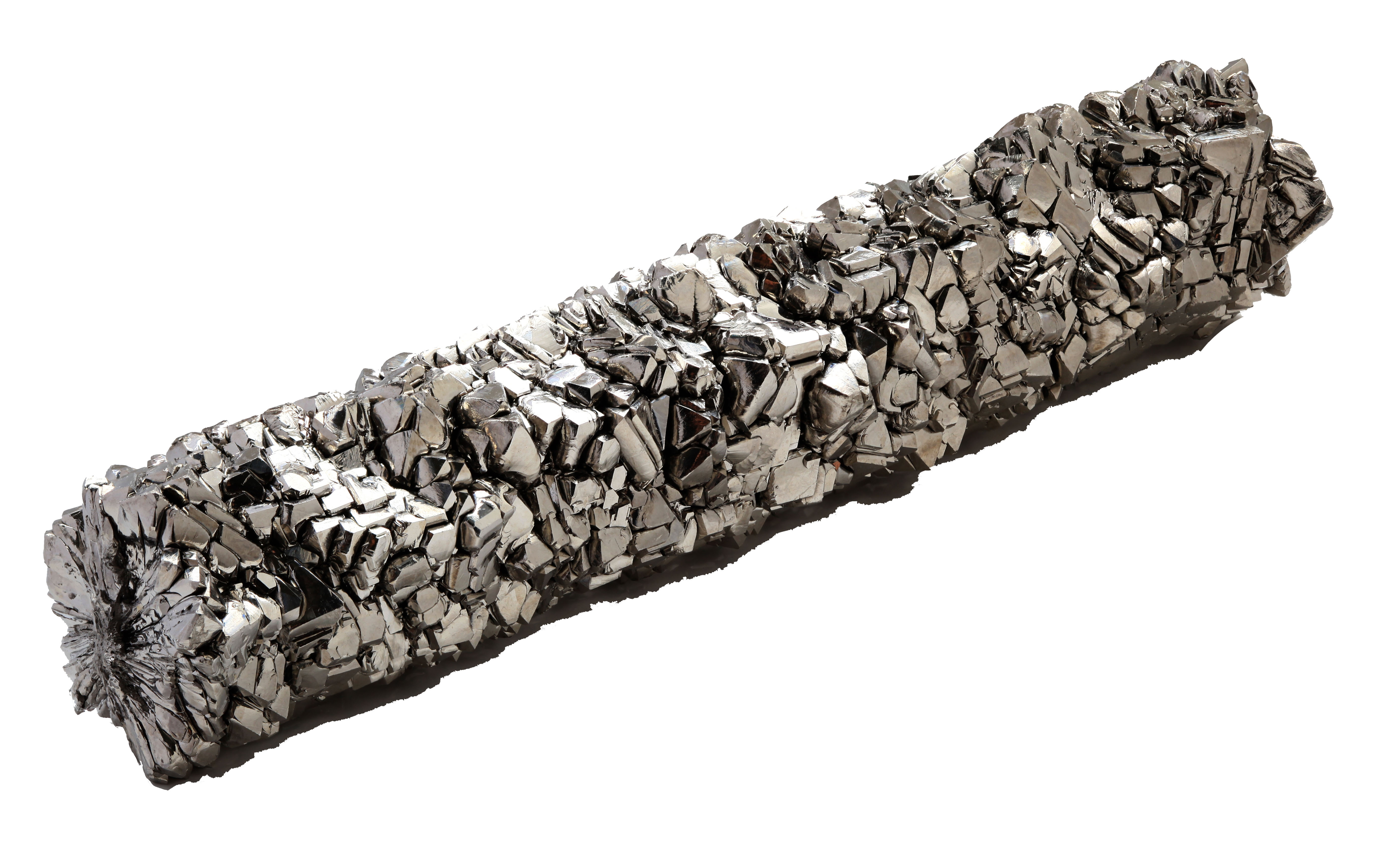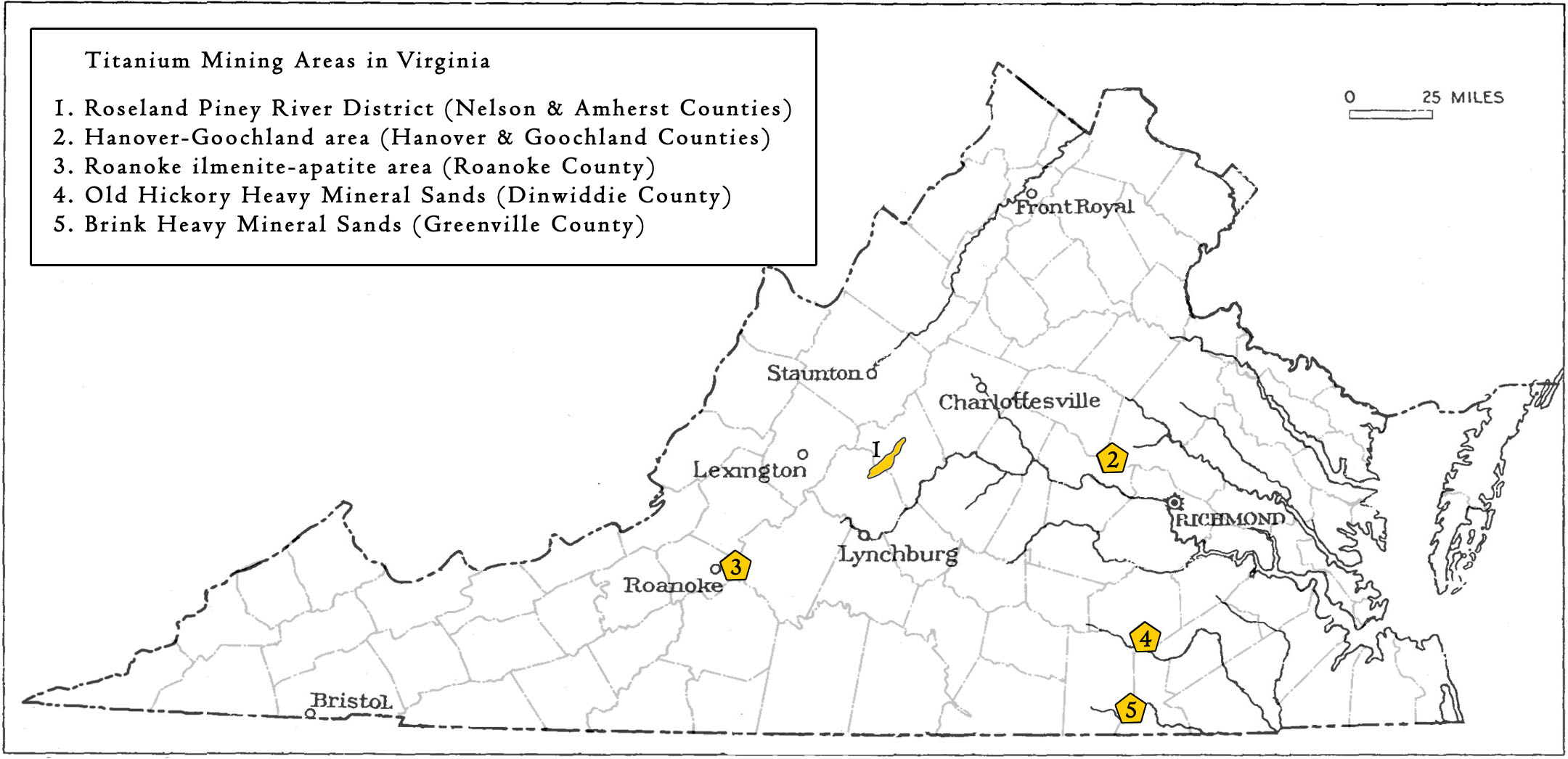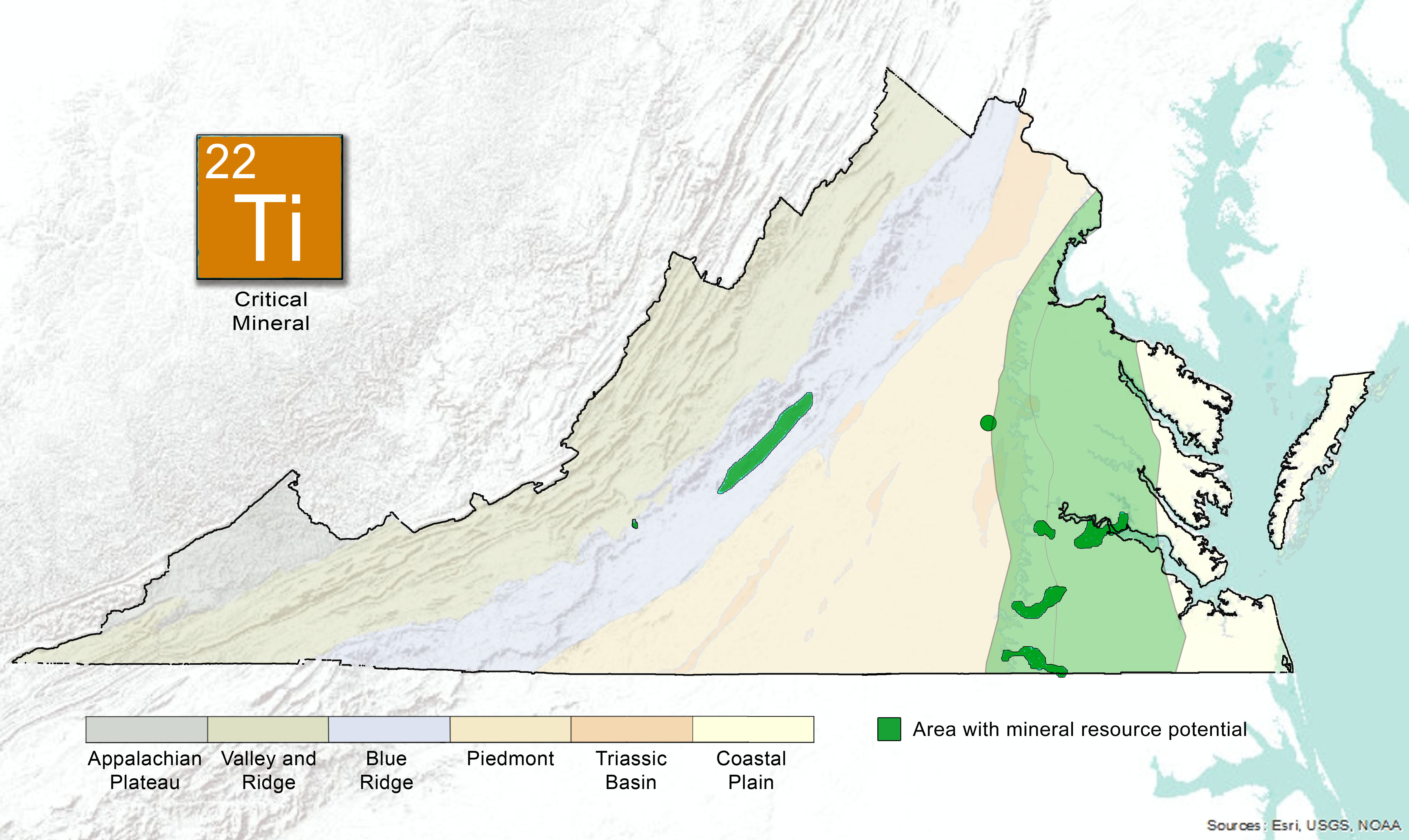Characteristics of Titanium
The element titanium is a very strong metal with a low density. Titanium is a non-magnetic silvery metal with the chemical symbol Ti. It is resistant to corrosion and has a very high strength-to-weight ratio. Titanium is predominantly associated with the minerals rutile and ilmenite (Table 1). Titanium is used mainly as titanium dioxide for white pigments.


| Mineral Name | Chemical Formula | Specific Gravity | Ti % |
|---|---|---|---|
| Rutile | TiO2 | 4.25 gm/cc | 59.94 |
| Ilmenite | Fe+2TiO3 | 4.79 gm/cc | 31.56 |
| Anatase | TiO2 | 3.88 gm/cc | 59.94 |
| Brookite | TiO2 | 4.12 gm/cc | 59.94 |
| Perovskite | CaTiO2 | 4.03 gm/cc | 35.22 |
| Titanite | CaTiSiO5 | 3.55 gm/cc | 18.16 |
Table 1: Minerals containing the element Titanium

Uses of Titanium
Although titanium was discovered in 1791 it was not used outside of the laboratory until the 20th century, when scientists were able to separate it from host minerals, a difficult and costly process. Titanium is considered a "critical mineral" in domestic metallurgical applications that serve aerospace, defense, and energy technologies (Fortier and others, 2018). The main uses of titanium dioxide are for pigments and titanium metal used for alloys in the steel industry. By the 1950s, titanium was applied to the production of military aviation design requiring light-weight strength. Due to its resistance to high temperatures and low density the majority (80 percent) of titanium is now used for aerospace technology. Other applications include chemical processing, power generation, pigments, and marine hardware. Titanium is nontoxic and nonreactive with living tissue, making it safe to use in medical procedures requiring implants, pins and artificial joints.

An ilmenite crystal.
Photo courtesy Robert Lavinsky https://www.mindat.org/photo-65675.html
Titanium Geology
The element titanium does not exist in its elementary form in nature, rather it is typically in chemical combination with either oxygen or iron. Bound with oxygen, titanium oxides may be present in a wide variety of high temperature and pressure igneous rocks within minerals such as rutile and ilmenite. Titanium-enriched minerals ilmenite and rutile are common constituents in many metamorphic, igneous, and sedimentary rocks, as well as quartz veins. Titanium-bearing minerals like rutile are resistant to weathering and are thus likely to weather out of host rocks and accumulate in saprolite, soil, or be transported and accumulate as heavy mineral sands in depositional environments. Anorthosite (a variety of gabbro that is composed mainly of calcic plagioclase feldspar and traces of iron-magnesium- aluminum silicate minerals) and nelsonite (a hypabyssal intrusive rock composed mainly of ilmenite and apatite with variable amounts of rutile) are the two main rock types that source titanium in Virginia (Pegau, 1956).
| Mineral System | Deposit Type | Geologic Provinces |
|---|---|---|
| Placer | Ilmenite/rutile/leucoxene | Coastal Plain |
| Iron-oxide-apatite (IOA) / chemical weathering | residual concentration and magmatic Ti-Fe-P (anorthosite, nelsonite) | Piedmont, Blue Ridge |
| Iron-oxide-apatite (IOA | magmatic Ti-Fe-P (nelsonite dikes) | Valley and Ridge and Piedmont |
Table 2: Prospective titanium mineral systems, deposit types (Hofstra and Kreiner, 2020), and geologic provinces in Virginia
Titanium in Industry
Titanium is relatively abundant on Earth, although typically distributed in low concentrations. The U.S. does not maintain a supply of titanium in the National Defense Stockpile and is 91 percent reliant on imports from Japan, Kazakhstan, Ukraine, China, Russia, where significant ilmenite deposits exist. In the United States, titanium is mined in smaller amounts in Nevada and Utah. Virginia is one of only three U.S. states currently producing titanium minerals.
In Virginia, titanium has been mined in several locations, sourced from the minerals ilmenite (FeTiO3) and rutile (TiO2). Beginning around 1900, mining increased until Virginia had become the primary producer of ilmenite and rutile concentrates in the United States from 1939 until about 1944. By 1950, rutile production had ended in Virginia, but ilmenite production totaled an estimated 30 thousand tons (Pegau, 1956).
Nelson and Amherst CountiesTitanium was first mined in Virginia 1901. The location, referred to as the Roseland Piney River district, consists of anorthosite rock extending in a southwesterly direction from southern Nelson County into Amherst County, a distance of about 13 miles (see map below). In the Roseland Piney River district, nelsonite occurs as dike-like intrusive bodies within and at the margins of the Roseland anorthosite, which contains disseminated rutile and ilmenite. Ross (1941) reported evidence for ilmenite replacement in the nelsonite dikes, while others have suggested a cogenetic origin via magmatic segregation (Watson and Tabor, 1913; Kolker, 1982) or as a combination of cumulate origin and mobilization into the dike-like bodies (Dymek and 0wens, 2001). These titanium-rich rocks weather to produce titanium-rich saprolite. Most of the historic production of rutile and ilmenite was derived from saprolite developed over the weathered bedrock sources in the Roseland-Piney River district. The extracted titanium was initially used as a coloring agent in ceramics. Beginning around 1920, ilmenite from this district was also mined and processed to extract titanium for use as a paint pigment and in titanium-steel alloys. Titanium mining in the Roseland Piney River district ended in 1971.

Areas mined for titanium in Virginia
In 1910, rutile deposits were discovered in the eastern Piedmont in Hanover and Goochland Counties (see #2 on the map above). Here, thick saprolite mantles granitic biotite gneiss, which is cut by rutile- and ilmenite-bearing pegmatite dikes and diorite, diabase and pyroxenite (Watson, 1913). Rutile with ilmenite have weathered out of the host rock and can be found as fine sand and masses within the overlying saprolite (Watson, 1913).
Today, industrial grade feldspar is mined in Hanover County from the Montpelier metanorthosite. This coarse-crystalline metamorphosed anorthosite body intruded Proterozoic rocks of the Goochland terrane in the eastern Piedmont. The Montpelier metanorthosite was originally mined for titanium-bearing rutile and ilmenite by Metal and Thermit Corporation starting in 1957. The property was acquired by U.S. Silica Corporation in 1993 and since that time has produced feldspar and silica products from mining and processing operations near Montpelier, just northwest of Richmond.
Roanoke CountyTitanium minerals were also mined on a small scale in Roanoke County. The rock nelsonite containing ilmenite and apatite was first identified in this area as early as 1890. Although some ilmenite-rich ore samples were mined and processed in Richmond, and there are records of subsequent mineral prospecting in the area, the site was abandoned and no further mining occurred (Watson and Taber, 1913).
Dinwiddie and Greensville CountiesIn eastern Dinwiddie and Greensville Counties, economic heavy mineral sands containing titanium occur as paleoplacer deposits along a now exposed ancient coastline. The heavy minerals were naturally concentrated in Pliocene-age shoreline beach and dune sands by wind and wave action. The key heavy minerals in these deposits include ilmenite, rutile, zircon, and leucoxene (mixture of altered titanium bearing minerals). In 1996, mining and processing of the heavy mineral sands began from the Old Hickory deposit. A second mine (Brink) was permitted about 19 miles to the south in Greensville County in 2008. At both sites, heavy mineral sands are mined by excavator and then processed to separate each heavy mineral (ilmenite, leucoxene, rutile, and zircon) by weight and magnetism. In 2017, Iluka Resources Ltd. suspended operations, but continues to hold mining leases in these areas.
As of 2024, Atlantic Strategic Minerals have restarted mining operations at their Millrun Mine near Stony Creek, VA (https://www.atlanticstrategicminerals.com/). Additional investigations regarding heavy mineral sands hosting titanium resources have been completed as part of the Earth MRI program.
The Pliocene heavy mineral sand deposits are considered an onshore analog for what may represent an undiscovered economic resource contained in sand shoals that have formed on Virginia's outer continental shelf. In an investigation that included analysis of 390 sediment samples from offshore vibracore and grab samples, Berquist (1990) reported concentrations of one or more economic minerals that were equal to or greater than the economic cut-off grades for onshore deposits. The Virginia Division of Geology and Mineral Resources is conducting investigations to assess the offshore resource potential.
Halifax CountyAs of 2024, the company IperionX was constructing a new facility for recycling of titanium in Halifax County. Additional details may be found on the IperionX website.
Selected References:
Berquist, C.R. Jr., 1990, Chemical analyses of offshore heavy-mineral samples, Virginia inner continental shelf. In: Berquist, C.R., Jr., (ed), Heavy mineral studies Virginia inner continental shelf: Virginia Division of Mineral Resources Publication 103, p. 109- 124.
Dymek, R.F. and Owens, B.E., 2001, Petrogenesis of apatite-rich rocks (nelsonites and oxide-apatite gabbronorites) associated with massif anorthosites: Economic Geology v. 96, p. 797- 815.
Fortier, S.M., Nassar, N.T., Lederer, G.W., Brainard, J., Gambogi, J., and McCullough, E.A., 2018, Draft Critical Mineral List - Summary of Methodology and Background Information - U.S. Geological Survey Technical Input Document in Response to Secretarial Order No. 3359: U.S. Geological Survey Open-File Report 2018-1021, 15 p.
Hofstra, A.H., and Kreiner, D.C., 2020, Systems-Deposits-Commodities-Critical Minerals Table for the Earth Mapping Resources Initiative: U.S. Geological Survey Open-File Report 2020-1042.
Johnson, S. S., 1964, Iron and titanium mineral pigments in Virginia: Virginia Minerals, v. 10, n. 3, p. 1-6.
Kolker, A., 1982, Mineralogy and geochemistry of Fe-Ti oxide and apatite (nelsonite) deposits and evaluation of the liquid immiscibility hypothesis: Economic Geology v. 77, n. 5, p. 1146-1158.
Newton, M.C. and Romeo, A.J., 2006, Geology of the Old Hickory heavy mineral sand deposit, Dinwiddie and Sussex Counties, Virginia. In: Reid, C.J. (ed), Proceedings of the 42nd Forum on the Geology of Industrial Minerals. North Carolina Geological Survey, Information Circular 34, p. 464-480.
Pegau, A. A., 1956, Titanium: Virginia Division of Mineral Resources, Mineral Resources Circular 5, 17 p.
Ross, C.S., 1941, Occurrence and origin of the titanium deposits of Nelson and Amherst Counties, Virginia: U.S. Geological Survey Professional Paper 198, 59 p.
Watson, T. L., and Taber, S., 1913, Geology of the titanium and apatite deposits of Virginia: Virginia Geological Survey Bulletin III-A, 308 p.
Watson, T. L., 1913, The Rutile Deposits of the Eastern United States, Contributions to Economic Geology, part I.


.jpg)
